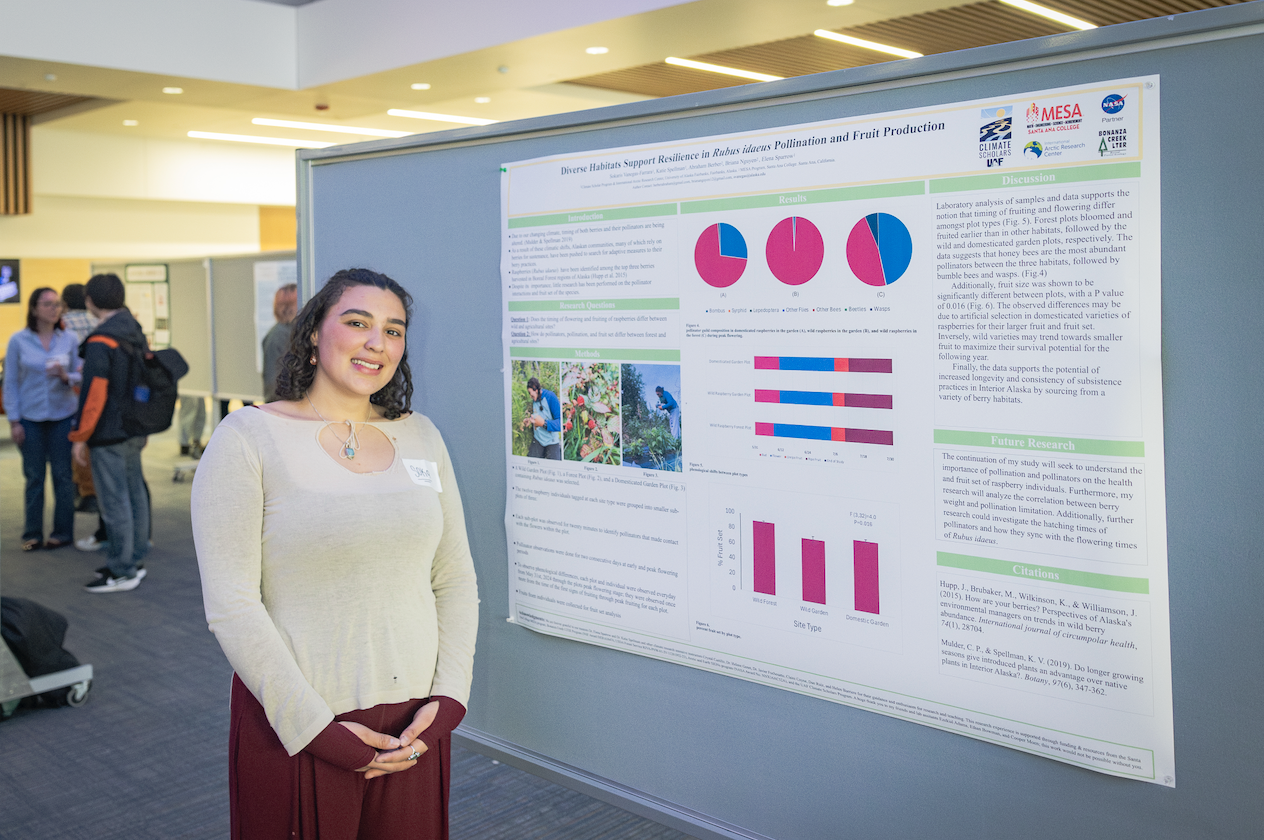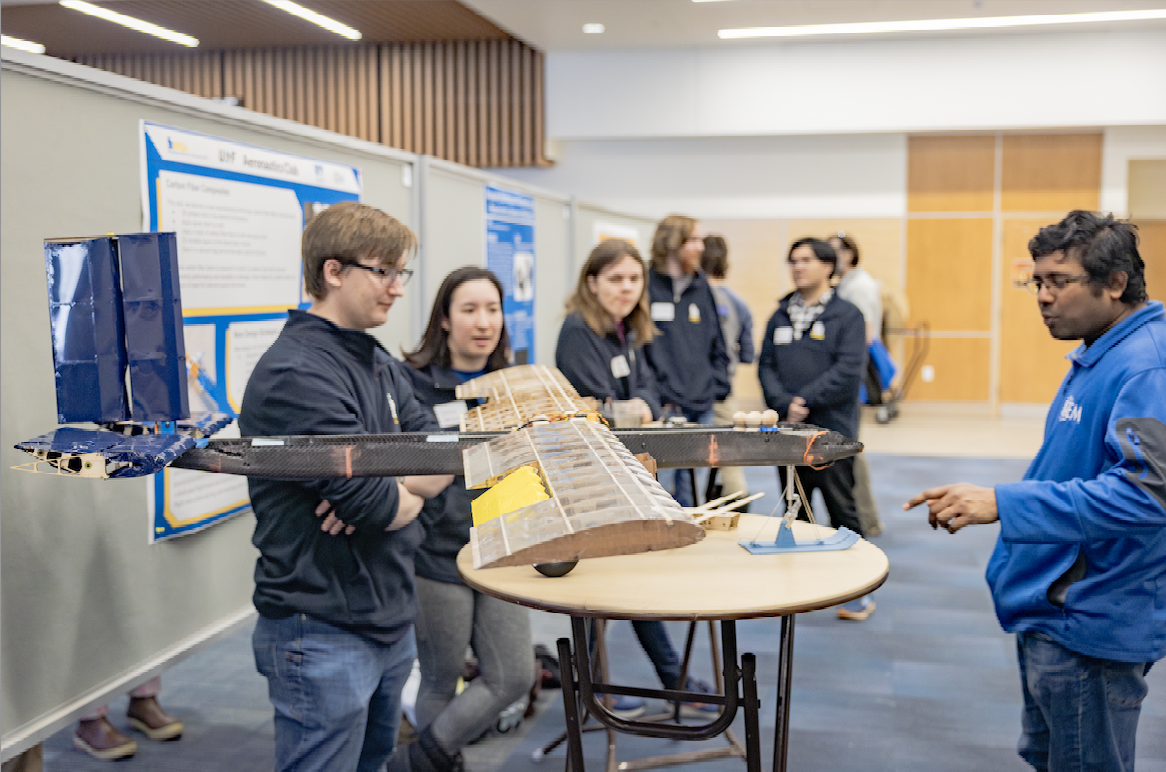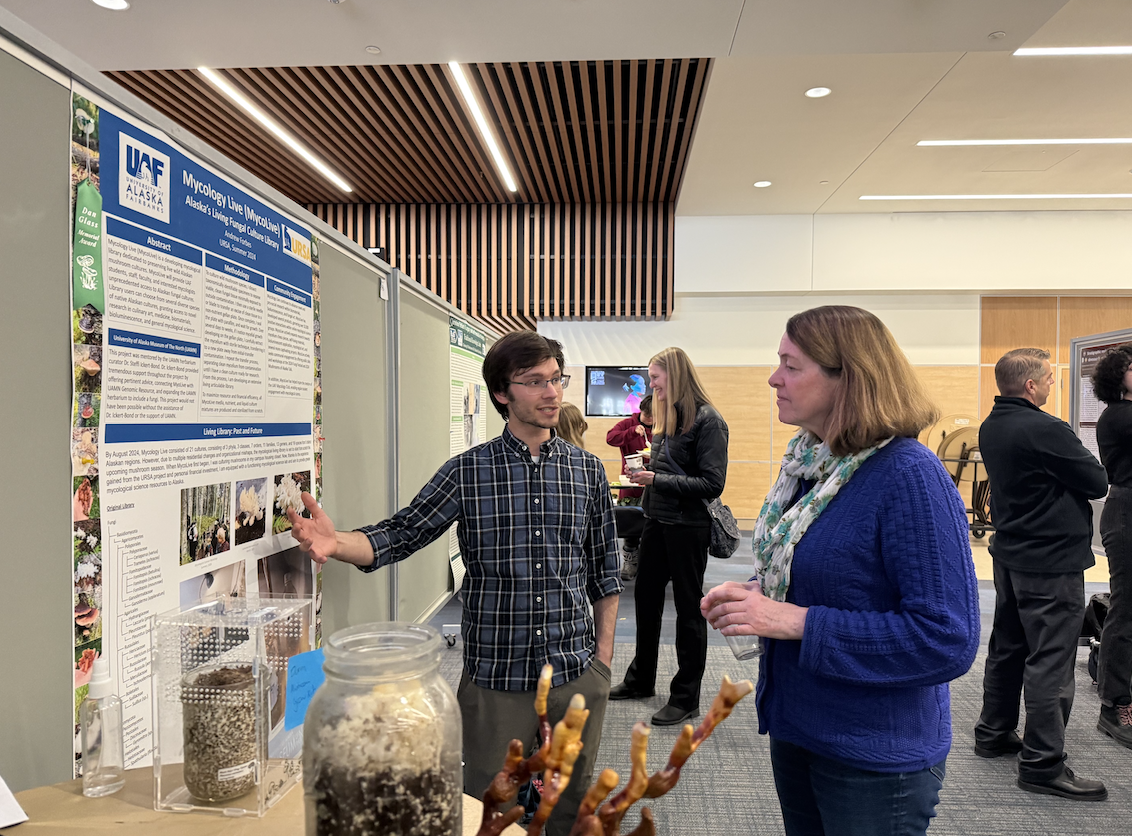2025 Research and Creative Activity Day
| Presenter | Project | Poster |
|---|---|---|
|
Adrian Burke |
STARTRAM - Sensor Technology for Alaska Rural communities Targeting Remote Atmospheric Monitoring Mentor: Dayne Broderson STARTRAM explores and evaluates environmental sensor platforms that are suitable for reliable cold-climate deployments and educational contexts to support ongoing and future environmental monitoring initiatives. Methodology includes both qualitative analysis and experimental testing to identify strengths, weaknesses, and relevant niches of sensor technologies. |
Poster |
|
Petie Deveer Hailey Hodgins |
Powering and Unifying Long-ranged Sensor Ecosystems (PULSE) Mentor: Dayne Broderson Our project is called Powering and Unifying Long-range Sensor Ecosystems (or PULSE). The project focuses on evaluating technology for remote sensing applications; namely, non-cellular communication and solar power. The goal is to work with high school students and evaluate the technology's effectiveness as a tool for learning, while also looking at the viability of the data collected for citizen science applications. |
Poster |
| Presenter | Project | Poster |
|---|---|---|
|
Amber Bratlie |
Marketing Around the World Mentor: Tammy Tragis-McCook Marketing strategies are shaped by culture, war, and economic conditions worldwide. This study explores how cultural values influence messaging, how conflict shifts priorities and increases patriotism, and how economic disparities drive luxury and sachet marketing. By analyzing global trends, we highlight the need for brands to adapt to regional challenges. |
Poster |
| Presenter | Project | Poster |
|---|---|---|
|
Adrian Antonio Blake Bushnell Tyler Lynch |
Mapping Buildings and Structures Using a Rover with an Attached LiDAR System Mentor: Dr. Richard Wies, Jr. The project is an semi autonomous rover to navigate and create a 3D map of a building. The goal is to develop a fully autonomous mapping system for preservation, inspection, and exploration of structures. |
Poster |
|
Alex Armstrong Blake Bushnell Casey Lambries |
UAF Aeronautics Club Mentor: Dr. Michael Hatfield The UAF Aeronautics Club aspires to design and manufacture unmanned radio controlled (RC) aircraft. Developing improved techniques to continuously advance the club's capabilities is our priority along with training and educating future engineers and RC pilots in their specific area of interest. |
Poster |
|
William Caldwell Nicholas Dugger Cody Lee |
Phasor Measurement Unit (PMU) Project Mentor: Dr. Richard Wies, Jr. This project will address a need for better and faster grid monitoring for circumpolar energy grids (focusing on Alaska) by creating a custom-designed Phasor Measurement Unit (PMU). The project team envisions this PMU providing low-cost and effective real-time monitoring of grids, which will help electrical service providers and crews respond to faults, such as downed power lines, and help prevent those faults from igniting wildfires. Low-cost PMU incorporation will also allow the safe integration of renewable energy sources into the grid, by saving operators and consumers money from inefficient power and wasted power. |
Poster |
|
Joules Evergreen Jack Kendall Koen Ross |
Microgrid Variable Voltage Emulator Mentor: Dr. Richard Wies, Jr. Many devices used by the Federal Aviation Administration (FAA) in Alaska are tested in the Lower 48, where power quality is both more ideal and consistent. The Microgrid Variable Voltage Emulator (MVVE), will allow the FAA to test their equipment for remote Alaskan conditions before deployment. |
Poster |
|
Jonas Fields |
Dendrochronology and the Mile 11 Landslide in Wrangell, Alaska Mentor: Dr. Margaret Darrow My goal was to find out if trees caught in the landslide had any clues of slope movement before the landslide occurred. To do this, I sanded tree cookies, performed a LiDAR change detection analysis, and consulted with experts to better understand the Mile 11 landslide. |
Poster |
|
Remy Gray |
Decoding the Heath Impacts of Particulate Matter in Outdoor Air During Winter Using Gas Chromatography Mentors: Jenno J.L.H. & Dr. Srijan Aggarwal This study quantifying the health impacts on wintertime particulate matter (PM2.5) pollution by analyzing polycyclic aromatic hydrocarbons (PAHs). GC-MS and ICP-MS are used to analyze potential health impacts associated with exposure to PM2.5 and associated toxins. |
Poster |
|
McKenzie Helms Nicia Pfeffer Seth Waln |
Emergency Rescue UAV Payload Development Mentor: Dr. Michael Hatfield Search and Rescue (SAR) is a large issue in Alaska due to the harsh environment and vast uninhabited wilderness. For our senior design project, we decided to address this issue by developing an unmanned aerial vehicle (UAV) payload we call Field Integrated Navigation and Detection for Emergency Rescue (FINDER). |
Poster |
| Presenter | Project | Poster |
|---|---|---|
|
Tyra Best Cara Roberts |
Examination of Microplastic Content in Steller sea lions (Eumetopias jubatus) and Cassin’s auklets (Ptychoramphus aleuticus) Mentor: Kit Cunningham This project will document and compare the microplastic content and quantity in the diets of Steller sea lions and Cassin’s auklets. Due to their distinct diet differences, this comparison will allow for a more holistic understanding of microplastic accumulation within the marine food web and where microplastic accumulation might be occurring. |
Poster |
|
Linnaea Doerner |
Microplastics in Bearded Seal Tissues Harvested in the Early 2000s and Recent Years Mentor: Dr. Lara Horstmann Plastic pollution, especially microplastics (MP), contaminates marine environments, including the Arctic. This study examined MP in tissues of bearded seals from Alaska. All tissues contained MP, with muscle showing the highest concentration. MP levels were stable between 2010-2011 and 2021-2023, indicating persistent exposure over time. |
Poster |
|
Queenie Turner |
Bivalves in Jakolof Bay, Alaska occupy different positions in the food web Mentor: Josianne Haag While scallop farming is currently not widespread in Alaska, it holds the potential to garner interest in the coming years. For this project, I will characterize the food sources of seven bivalve species collected in May 2024 from Jakolof Bay, Alaska. |
Poster |
|
Queenie Turner |
Microplastics in subsistence harvested bowhead whale stomach, colon, and muscle Mentor: Dr. Lara Horstmann Microplastics (particles < 5mm) are present in all oceans. They were isolated from marine mammals harvested by Alaska Natives, making this emerging contaminant concerning for animal and human health. We will analyze bowhead feces and tissues to understand microplastic uptake and accumulation in an endangered Arctic species of subsistence importance. |
Poster |
| Presenter | Project | Poster |
|---|---|---|
| Lissa Kramer |
Introduced Plants in Bethel, Alaska Mentor: Lisa Strecker Poster illustrating oral histories gathered from Elders in Bethel talking about introduced plants. |
Poster |
| Presenter | Project | Poster |
|---|---|---|
| Jodi Fouché |
Unearthing the History of Plant Utilization: An Analysis of Botanical Remains Collected from the Chena Townsite Mentors: Dr. Justin Cramb & Lisa Strecker Participating in site excavation, I investigated the historical plant-use practices of Chena Townsite settlers (1902-1921) by identifying archaeological plant remains obtained from the site. By fusing archeological findings and archival sources (APRCA) with contemporary ethnobotanical practices, this project aimed to vividly depict the evolving ethnobotanical landscape of Interior Alaska. |
Poster |
|
Rodolfo Garcia |
Salivary Cortisol and Correlations to Academic Performance Mentor: Dr. Jennifer Peterson Stress has far-reaching consequences, not just for individuals but society generally. How do we mitigate these consequences of stress and workload? This study was unable to make strong conclusions about correlations between cortisol but weak correlations exist which may be more well-emphasized by a larger sample size. This study helped to generate a concrete future methodology that may be replicated in the future at greater length. |
Poster |
|
S. Naomi King |
Cultivating Communi-TEA Mentor: Dr. Sarah Stanley Poster explaining the behind-the-scenes process of planning and executing Tea Time for the English student community. |
Poster |
|
Irina Koval |
Beyond the First Semester: Unpacking Student Motivation and Retention Challenges in Russian Language Learning Mentor: Dr. Wendy Whitehead-Martelle A poster showcasing why Russian courses at UAF experience significant drop-off after one or two semesters. This student-driven research project explores why students start Russian, why many stop, and what support structures could help them continue. |
Poster |
|
Julia Lockwood |
Earthquakes in South America and Japan Mentors: Chisato Murakami & Dr. Eduardo Diaz This project will discuss earthquakes in Latin America and Japan, specifically in the Kanto Region. Specifics on the Nankai Cycle will also be discussed. This presentation is meant to highlight the use of language, and will be presented in English, Spanish, and Japanese. |
Poster |
|
Samantha Nixon Jennelle Smyth Kieleigh Williams |
ACEs and Health Aging Mentor: Dr. Jennifer Peterson Our study aims to examine the relationship between adverse childhood events and healthy aging among older Alaskans. |
Poster |
|
Tsubasa Roberts |
Earthquake Disasters and Preparedness Mentors: Chisato Murakami & Dr. David Henry Research on major earthquake risks in North America and Japan, covering disaster impact and preparedness, presented in both English and Japanese. |
Poster |
| Presenter | Project | Poster |
|---|---|---|
| Madelyn Brennan |
Mitochondrial succinate dehydrogenase enzyme activity in hibernating black bears Mentor: Dr. Sarah Rice Black bears suppress their metabolism by 75% in hibernation and 50% during spring emergence, but the mechanisms regulating metabolic suppression are unknown. Studies in hibernating ground squirrels have suggested that inhibition of mitochondrial succinate dehydrogenase activity (SDH, complex II) could play a role in metabolic suppression. SDH activity has not been measured in hibernating black bears before. We hypothesized that SDH activity would be lower during hibernation and spring emergence compared to summer levels in kidney, cardiac, skeletal muscle, and liver tissue of black bears. |
Poster |
|
Anastasia Chen |
Quantifying and Comparing Air Pollution Near the Fairbanks International Airport and Downtown Mentor: Dr. William Simpson We measured and analyzed ambient PM2.5, CO2, and temperature near the Fairbanks International Airport. Ambient PM2.5 and temperature measurements at three other regulatory monitoring sites in/near Fairbanks were analyzed. The airport region had the lowest 3m PM2.5 concentrations out of the sites studied and the largest temperature inversion strengths. |
Poster |
|
Julian Doyle |
Investigating the Effects of Vitamin D Supplementation on Juvenile Dogs: A Preliminary Study Mentor: Dr. Scott Jerome This study evaluated the effects of vitamin D3 supplementation in juvenile dogs over 90 days. Despite prior evidence supporting supplementation, no significant differences in serum 25(OH)D levels were found across baseline, supplementation, and washout phases. Vitamin D content in commercial dog food and supplements was also analyzed to inform dietary guidelines. |
Poster |
|
Cedar Hanger |
Reconstruction of Fire History and its Connection to the Arrival of Spruce from Windmill Lake, Interior Alaska Mentor: Dr. Nancy Bigelow Analyzing pollen and counting charcoal in samples taken from cores retrieved from Windmill Lake in order to determine fire history and whether or not it correlates to the arrival of spruce in Interior Alaska. |
Poster |
|
Michelle Ramirez |
Microbial Response to Permafrost Thaw and Coalescence Mentor: Dr. Mario Muscarella Permafrost thaw is a major concern for the Arctic and sub-Arctic regions because it can emit large amounts of stored carbon into the atmosphere as carbon dioxide or methane. These greenhouse gasses (GHG) are controlled by microbial activities. Permafrost thaw will let the frozen and active layer soils mix, allowing the microbial communities to form new mixtures of organisms and organic compounds. With increasing temperatures, this could be vital to understand how microbes impact gas flux and their soil ecosystem. |
Poster |
|
Dorothy Sherer |
Identifying bacterial infection in Alaskan small mammals Mentor: Dr. Cristina Hansen Through this project, I identified bacterial DNA in small mammals that could be common carriers for zoonotic disease. The bacterial species found could be used to understand what bacterial infections could spread to other animals and to people. |
Poster |
|
Grace Veenstra |
Modeling salmon life histories through growth and development using integral projection models Mentor: Dr. Lisa Crozier I developed a temperature-dependent integral projection model to predict the growth and development of a population of Chinook salmon on the Snake River during their freshwater lifestage. Despite the simple set of parameters, I am able to get accurate predictions to the range of observed sizes. This model framework is widely applicable to modeling population variables spatially or temporally. |
Poster |
|
Chelsea Wettroth |
Research design optimization for determining hibernation and spring emergence of Little Brown Bats (Myotis lucifugus) Mentor: Dr. Todd Brinkman Little brown bats (Myotis lucifugus) are the only species of bat that has been reported in Interior Alaska and are typically located by ultrasonic monitoring. M. lucifugus emit social calls that are characterized as high intensity frequency modulated (FM) sweeps ranging from 80 kHz down to 40 kHz. This poster aims to focus on study design using ultrasonic monitoring to locate M. lucifugus for future studies by the Wildlife Society . |
Poster |
| Presenter | Project | Poster |
|---|---|---|
| Lee Aeo |
Measuring Erosion Rates of Rocks to Quantify Their Carbon Capture in Alaska Mentor: Dr. Florian Hofmann Igneous rocks are capable of capturing CO2 from the atmosphere and permanently storing it. Data on this process in Alaska is sparse. This study aims to quantify the erosion rate of igneous rocks in Alaska and assess the impact on long-term carbon storage. |
Poster |
|
Ada Causey Cori Patchkofsky |
Timing of Volcanic Eruptions on Unalaska Mentor: Dr. Florian Hofmann Knowing the ages of past volcanic eruptions is important for the assessment of volcanic activity and hazards. Our goal is to reanalyze past samples from volcanic features on Unalaska and determine their ages. This data can be used for future hazard mitigation and sample analysis. |
- |
|
Cole Osowski Sarah Finney |
Alaska’s Volcanic-Climate Policymaking Review & Recommendations Mentors: Dr. Amy Lauren Lovecraft & Dr. Nathan Graham We outline the links between climate change and volcanic activity, Southcentral Alaska’s volcanic risks, current response policies in place and identify key policy recommendations to improve resiliency. |
Poster |
| Presenter | Project | Poster |
|---|---|---|
| Aila Berrigan |
Does microclimate variation in tundra ecosystem drive microbial community assembly? Mentor: Dr. Mario Muscarella In this project, I will analyze soil samples from a polygonal tundra landscape to study microbial communities and their metabolic activities, focusing on how microclimate variation drives the composition taxa present and their metabolic activity. |
Poster |
|
Danny Casner Monica Casner |
DNA sequencing of Hoary Marmot (M. caligata) stomach contents through metabarcoding Mentor: Dr. Diana Wolf This poster presents our results from using metabarcoding DNA to examine diets of
alpine and coastal Hoary marmots. Hoary marmots (Marmota caligata) are herbivores
distributed widely throughout alpine habitats from southern Washington, Idaho, and
Montana north to the Yukon River in Central Alaska. In Southeast Alaska, however,
they are also found at sea level. As the tree line rises in elevation in response
to climate change, alpine habitats are expected to shrink. Most hoary marmots occupy
alpine tundra and rocky talus. There is an ecological knowledge gap on the diet of
M. caligata, including comparing diet at sea level with alpine forage. Determining
diet is key to understanding hoary marmots’ ability to thrive on a changing landscape.
Alpine-dwelling marmots are thought to feed on grasses, flowering plants, mosses,
roots, and lichen. As of yet, we know nothing about the diet of beach-dwelling marmots.
We used DNA sequencing (metabarcoding) of M. caligata stomach contents to identify
and compare their diets in alpine and sea-level habitats. Our results will help to
fill in critical knowledge gaps in hoary marmot ecology and address hoary marmots’
potential resilience to changing climate.
|
Poster |
|
Chloe Farkas Enica King |
Parasympathetic activity and heart rate in hibernating black bears Mentor: Dr. Oivind Toien This poster presents preliminary results from electrocardiogram data collected from three American black bears for one season between 2008 and 2009. We examine maximum R-R interval and compare parasympathetic activity (measured using RMSSD/RRI) and average heart rate in hibernation and in summer. |
Poster |
|
Mackenzie Hawkins |
An International Biomarker of Added Sugar in Adults Mentor: Dr. Jessica Johnson & Dr. Diane O'Brien The overall aim of this project is to evaluate the natural abundance carbon isotope ratio (CIR) as a biomarker of added sugar intake in adults across internationally diverse populations. In this poster, I present the isotopic biomarker results from participating studies in four countries. |
Poster |
|
Nivedita Menon |
Mitochondrial complex I function during different physiological states in black bear tissues Mentor: Dr. Sarah Rice My project is on determining the activity in mitochondrial complex I of spring, summer, and hibernating black bear tissue to further understand mitochondrial function during unique states of metabolic suppression in bears. |
Poster |
|
Stella Organek |
Opportunistic Mount Rainier and Adam's Climb Pilot Study: Developing Methodological Framework for Monitoring Hydration Status in Acute Mountainous Environments Mentor: Dr. Sarah Rice This protocol is for an opportunistic study of climbers of Mount Rainier and Mount Adams. This pilot study’s main objective is protocol development for a future study researching hydration status in mountaineers, including verifying the relationship between urine color analysis and urine output to classical measurements of hydration. |
Poster |
|
Laura Serrato |
Spatial distribution of genetic diversity within Labrador Tea Mentor: Dr. Diana Wolf Arctic plant species are great model organisms for understanding climate change as they are some of the first to experience its effects. DNA sequencing and analysis of two Labrador Tea species, Rhododendron groenlandicum and Rhododendron tomentosum will provide an overview of their population ranges and possible changes in parts of Alaska, Canada and Russia. Additionally, the project will delve into the possible hybridization of these species in Alaska as previously seen in Canada, or possible environmental reasons for its lack thereof. |
Poster |
|
BreAnna Smith
|
Extracting Ancient DNA from the North Slope Mentor: Dr. Diana Wolf We have access to spruce wood that was found thawing out of permafrost on the North Slope. We have successfully extracted DNA from five of the eight samples. Our goal is to extract and sequence DNA from the samples, determine their species, and reconstruct past climates of the North Slope. |
Poster |
| Presenter | Project | Poster |
|---|---|---|
|
Akela Byrne |
Healthcare Providers' Perspective on Breastfeeding in Alaska Mentor: Dr. Julie Avery A qualitative analysis of strengths and barriers to breastfeeding in Alaska using semi-structured open-ended questions in focus groups of healthcare providers involved with breastfeeding/lactation and/or perinatal nutrition practicing in Alaska
|
Poster |
|
Travis Chiu |
Total Mercury (Hg) in seabird muscle tissue with respect to 3 auklet species in the Aleutian Islands Mentor: Stephanie Crawford I'll be looking at the total mercury (THg in ug/g) of 3 seabird species from muscle tissue samples, the Crested Auklet, Least Auklet, and Parakeet Auklet. From that data, I'll summarize my findings into a poster and discuss some patterns or differences if they arise. |
Poster |
| Presenter | Project | Poster |
|---|---|---|
| Ezekial Adams |
Effects of Soil Characteristics on Invasive Species Seed Bank Development after Wildfire Mentor: Dr. Katie Spellman Invasive plants have been found colonizing burned areas in interior Alaska, such as Melilotus albus (white sweetclover), which has seeds that can stay viable for up to 80 years. Soil factors can determine how long seeds are stored in the soil, and how successful germination will be in the event of a new disturbance. This research seeks to determine which soil variables can affect nonnative plant seed bank storage. These results can help predict which burned ecosystems are most vulnerable to nonnative species invasions. |
Poster |
|
Leanne Bulger |
Winter monitoring of a persistent snow cavity opening in an Alaskan boreal forest Mentor: Dr. Go Iwahana My winter study focused on the mechanisms that create a novel snow feature around a soil cavity and its opening in Fairbanks. Temperature, humidity, snow depth and gas data tell a story about climate change at the interface of geosphere, biosphere and atmosphere. |
- |
|
Mary Torok |
Equisetum growth on a permafrost gradient Mentor: Dr. Katie Spellman Poster research presentation of Equisetum growth in Bonanza Creek. |
Poster |
|
Sokaris Vanegas-Farrara |
Diverse Habitats Support Resilience in Rubus idaeus Pollination and Fruit Production Mentor: Dr. Katie Spellman I studied the pollination biology of Rubus idaeus as it relates to climate change, agriculture, and subsistence practices in interior Alaska. |
Poster |
| Presenter | Project | Poster |
|---|---|---|
| Daniela Barrera Guevara |
Stratigraphic revision of Coahuilaceratops magnacuera as the first dinosaur from the Lower Maastrichtian Cerro Huerta Formation Mentor: Dr. Patrick Druckenmiller On the basis of a new measured section, the long-frilled horned dinosaur Coahuilaceratops magnacuerna (previously reported from the Campanian Cerro del Pueblo Formation, in Northeastern Mexico) is herein reassigned to the Maastricthian Cerro Huerta Formation. These are the first dinosaur remains reported from this geological unit. As a consequence, this reassignment makes Coahuilaceratops up to ~2 million years younger than previously thought. This is more consistent with the relatively derived phylogenetic position of Coahuilaceratops, with implications for the southern Laramidia hypothesis concerning the origin of the Triceratopsini. |
Poster |
|
Channing Buckmaster |
Christine Heller's Legacy and the Potential for Integration of Traditional Knowledge Labels Mentor: Dr. Stefanie Ickert-Bond Christine Heller was a nutritionist whose work had an impact on Alaskan botany. Heller's work is relevant to discussions on the integration of Indigenous knowledge into memory institutions. For which the implementation of Traditional Knowledge Labels, which seek to safeguard Indigenous knowledge, may be useful. |
Poster |
|
Andrew Forbes |
MycoLive Mentor: Dr. Stefanie Ickert-Bond Mycology Live (MycoLive) is a developing mycological library dedicated to preserving living wild Alaskan mushroom cultures. MycoLive will provide UAF students, staff, faculty, and interested mycologists unprecedented access to Alaskan fungal cultures. Library users can choose from several diverse species of native Alaskan cultures, granting access to novel research in culinary art, medicine, biomaterials, bioluminescence, and general mycological science. |
- |
|
Xochitl Muñoz |
A comparatively large-bodied, high-latitude mammal from the Upper Cretaceous Prince Creek Formation of northern Alaska Mentor: Dr. Patrick Druckenmiller & Lauren Wilson The Prince Creek Formation (PCF) from northern Alaska contains a wide array of dinosaurs, birds, fishes and mammals. Previously known PCF mammals were small and shrew sized, as typical of the Mesozoic. However, we have found an arboreal cat sized mammal, making it one of the largest of its time. |
- |
|
Kristen Reece |
Curriculum Development: Teaching Genetics Through Hands-On, Field-Based Techniques for Youth Mentor: Dr. J. Andrés López Through our emerging project, “Sovereign Autonomy for Long-term Monitoring Of Non-human genes (SALMONg),” we aim to provide educational materials and technical support to interested communities and build local capacity for cost-effective monitoring of important species. |
Poster |








